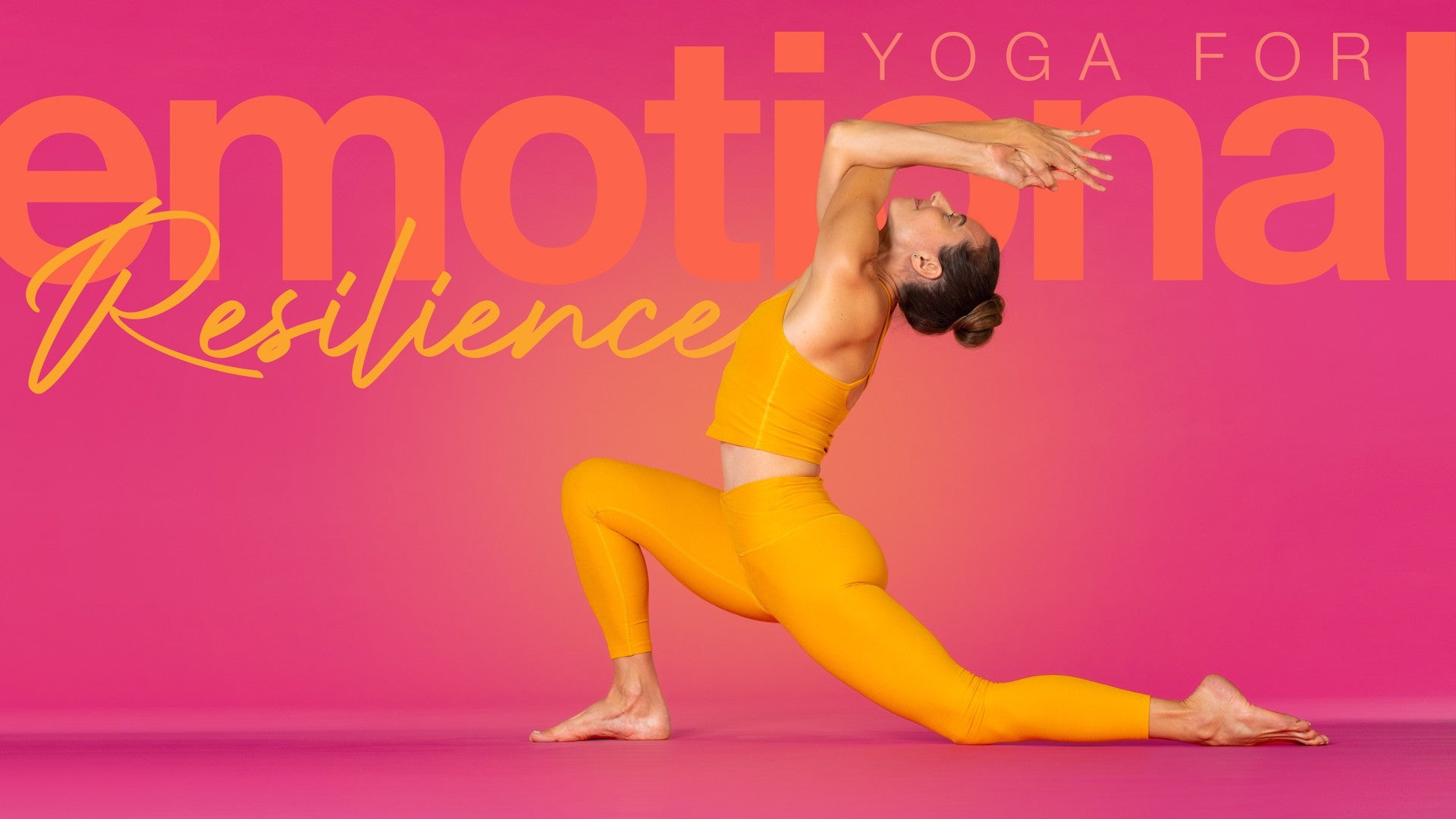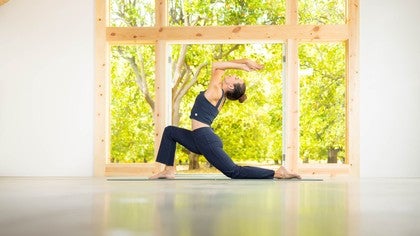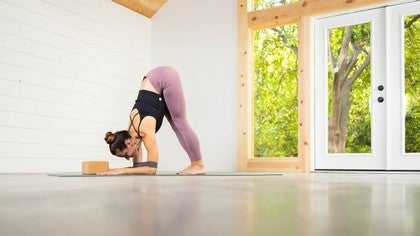Description
This challenging back bending class is designed to help us work through some of the difficult emotions that in Chinese medicine are associated with the lungs: sadness, grief, and sorrow. After a brief supine breathing practice, we get right into it with some core stabilizing work and shoulder and chest openers in preparation for back bending. We build heat in Sun Salute A's and B's, and play into Dhanurasana (Bow pose), Ustrasana (Camel pose), and Urdhva Dhanurasana (Wheel pose), with the option of trying Drop Backs. Maria also offers a great modification in Wheel pose with the use of props. We return to the floor for cooling poses, and a closing alternate nostril breathing practice. You will feel strong, confident, and optimistic.
See attached pdf for more information about the lungs and letting go, some journal prompts, and links to further reading.
About This Video
Transcript
Read Full Transcript
Welcome, today's yoga sequence was designed to heal the lungs and help us to work through some of the difficult emotions connected to the lungs, such as sadness, grief, and sorrow. So if you're going through a period of loss, loss of anything, then this is a great sequence to refer to. For this practice, you might need two blankets, two blocks, and one strap. So go ahead and grab them and come back to your mat. And we'll start lying down on our backs with our knees bent.
And we'll close our eyes and just start to check in with ourselves. Bring one hand to your heart. And let's start with the left hand at the heart and the right hand to the belly. We're just going to connect with our breathing here. You'll pay attention to what's going through the mind initially.
And we really practice letting that go and redirecting our focus to the breath and the physical body. And with the inhalations, you let the hands rise. With the exhalations, you'll feel them falling as that belly and the chest contract. And the more we can draw the inhale and the exhale, making them longer, smoother, softer, the more calming of an effect it has on our nervous system, which is really one of the most important aspects of healing, calming the nervous system and switching into parasympathetic. Let's take four more breaths here.
Deep long inhale, one. Now exhale, two. Deep inhale and exhale, three. Deep inhale and exhale, four. Really feeling the chest and the hands expand as you inhale and exhale, letting the belly and the chest fall and relax.
And from here, we're going to transition into some core exercises. Make sure that you have enough space to reach your arms up overhead. And we'll start with our arms down alongside the body, and we'll raise our legs up perpendicular to the floor. Take a deep breath in, and as you exhale, you'll roll your shoulders up and reach your fingertips forward, and then we're going to lower the right leg. And then inhale up and exhale down left, inhale up, exhale down right, inhale, three, four, right up, left down, five, switching, six, keep reaching your fingertips forward, raising the shoulders, seven, right leg down, then left, eight, nine, and ten.
Then raise the legs up to the ceiling, arms down, we'll take the arms up overhead, and we're going to start with the knees bent, feet on the floor, and from the arms up overhead, we'll reach up and come into like a Navasana shape, either leg straight or knees bent, and then we'll come down. We'll repeat this ten times. That was one, two, three, four, five, six, seven, eight, nine, exhale as you come up, ten. You can stay up, and we're going to take the left hand to the right knee, the right arm across the body, and we'll just do slow little pulses to the right. One, two, three, four, five, six, seven, eight, nine, ten, then we'll switch, right hand to left knee, left arm across the chest, one, two, three, four, five, six, seven, eight, nine, ten, then we'll lower the feet to the floor, roll down to our backs, arms alongside the body, and we'll raise the feet up to the ceiling and just start to raise and lower the hips, one, two, three, four, five, six, seven, eight, nine, ten, and we'll start that sequence again.
Raise the shoulders up, reach the fingertips forward, lower right leg, raise it up, left leg, that's one, two, we'll move through this a little quicker this time, three, right leg down, then left, four, right leg, then left, five, right, then left, six, seven, right down, left, shoulders stay lifted, eight, nine, and ten, left leg down, then bend your knees, bring the feet to the floor, arms up overhead, inhale, reach up into Navasana, and lower, that's one, two, three, four, five, six, seven, eight, exhale up, nine, inhale down, ten, from here, left hand to the outside of the right knee, if you need to you can bring your feet to the floor and we'll twist, one, two, three, four, five, six, seven, eight, nine, ten, other side, right hand to the left knee, left arm across the chest, one, two, three, four, five, six, seven, eight, nine, ten, lower down to the floor, legs up to the ceiling, one, lift the hips up to the ceiling, two, three, four, five, six, seven, eight, nine, ten, starting last time, raise the shoulders up, reach the fingertips forward, right leg lowers, left leg lowers, one, two, three, right, left, four, five, six, seven, eight, nine, ten, then bring the feet to the floor, knees bent, arms up overhead, with exhale come up to a Navasana shape, inhale lower down, feet to the floor, arms up overhead, two, three, four, five, six, seven, eight, nine, ten. Left hand to outside right knee, one, two, three, four, five, six, seven, eight, nine, ten, switch sides, right hand to left knee, one, two, three, four, five, six, seven, eight, nine, ten, come back to center, lower down, shoulders to the floor, feet to the ceiling, and start to lift your hips towards the ceiling, one, two, three, four, five, six, seven, eight, nine, ten. All done. And then let's just bring our feet, our legs straight, feet flexed, and we'll work on some shoulder openers, so we've stabilized the core, connects us to ourselves, keeps us stable through our center, and now we're going to start to open up the chest. So we're going to take our arms like goalposts, elbows bent, and fingertips up, hands in line with the head.
Right here, for some of us, we'll be feeling a big stretch across the chest. If you need to, you can elevate your shoulders by bringing one of your blankets underneath you, and then you want the heads of your shoulders to come to the floor. And that's a nice, gentle, but for some of us, quite intense, chest opener. And we're just going to take a few deep breaths here, and as you breathe, take the breath into the front of the rib cage, and see if you can direct the breath more between the collarbones and still continue to firm the front lower ribs in. And if this is a particularly challenging stretch, you have a lot of sensation here, it's an excellent way to, in kind of a restorative sense, to open up the chest and the shoulder girdle.
What's nice about it is it's not too active, it's very passive, so your nervous system can calm. All right, and then we'll come out of that, so you'll move your blanket aside if you've used one, and we're going to grab a block. And we'll take the block between the hands and right above the shoulders. The rest of your body is in Samasthiti, feet flexed, legs strong, belly pulled in, and we'll slowly bring the arms up overhead. And this should be very slow because we want to keep the arms nice and straight, and as we take the arms up overhead, we want to continually wrap the outer upper arms around towards the face as you reach the arms up overhead.
And they probably won't go down to the floor. Keep squeezing the block, and again, firm the front lower ribs in to the body, take the breath into the chest and also between the shoulder blades. It's almost like you want to widen your shoulder blades as you reach the block up overhead. And here we're just opening up the shoulder girdle because later on we're going to be doing some back bends. And then we'll release that, and we'll come up to seated, and then we're going to come onto our stomachs.
So coming to the front of your mat, point the toes, the feet can be separated hip distance apart, and start to spin the inner thighs up to the ceiling, and reach the baby toes to the floor, firm the outer ankles in. From here we'll interlace the fingers behind her back, roll the shoulders down the back, and start to peel the chest up off the floor, and we'll take five breaths here. As you breathe, with the exhale, press the pubic bone towards the floor. One, lengthen the back of the neck, two, three, four, for the last one, raise the legs up as high as you can, lift the chest a little higher, then keep the legs lifted, release the hands, set them flat on the floor, and press yourself up into either a high cobra, or if you have it in you, straighten the arms and let the thighs come up off the floor as you come into a full upward facing dog. And then exhale, lift the hips up, curl the toes under, and take downward facing dog.
This one we'll pedal out the feet, reach the left heel down, and then the right heel down. Stay connected to your breathing, inhaling and exhaling with the transitions. And then we'll settle down with both heels reaching to the floor. Push the floor away from you. Remember that same sensation we had as we were holding onto the block between the hands?
Try to create space between the shoulders with the inhalation, but then also reach like you're pushing the floor away from you as you lengthen the arms out of the waist. Take one more deep breath in. And then as you exhale, look forward and walk your feet to your hands. With the inhalation, you can bring the hands to the shins or the fingertips to the floor. Inhale and fold, warming up the hamstrings.
Let's do a couple rounds of that. Inhale again, lengthen. Exhale fold. And this next inhale will come all the way up to the top. Arms reach up overhead.
And exhale, arms down alongside the body. Sree Namaskar. Today, inhale, arms reach up overhead, push down through your feet as you reach to the ceiling. Exhale, hinge at the hips as you fold forward. Inhale and lengthen.
Keep the hands flat on the floor. Step back to the top of a push up. Shift forward and lower down. Either come to cobra or if you can, upward facing dog right away. Inhale, lift the chest.
And exhale, downward facing dog. You deep breaths here. With the inhalation, feel the expansion. Exhale, you reach a little further into your stretch. End of your next exhale.
Look forward, bring your feet to your hands. Inhale to lengthen. Exhale to fold. Inhale arms reach up. Exhale arms down.
And again, inhale, arms reach, Sree Namaskar A. Exhale and fold. Inhale lengthen. If you're comfortable jumping to Chaturanga, feel free on the next two rounds. We lower. Exhale cobra or up dog.
Exhale downward facing dog. Keeping the mind focused on the sound of the breath. Inhaling and exhaling through the nose. Mouth stays closed. Really feeling the expansion of the lungs as the rib cage expands.
With exhalation, fully exhaling and allowing the rib cage to contract. Push out the old breath. End of your next exhalation. Look forward, step, or you have the option to jump. Inhale to land, look up.
Exhale to fold. Inhale all the way up. And exhale arms down alongside the body. One last one, inhale, exhale fold. Inhale and lengthen.
Exhale step or jump to Chaturanga. Inhale cobra or upward facing dog. And exhale back to downward facing dog. Holding and breathing. Let the breath be the priority here.
Focusing on deep long inhalations, full complete exhalations. At the top of your inhale, see if you can breathe a little deeper. And at the bottom of your exhale, see if you can let go a little deeper, a little more. End of your exhale, look forward, step or jump. Inhale lengthen, exhale fold.
Inhale coming all the way up. And exhale Samasthiti. Bend your knees, sit your hips back, reach the arms up overhead, Utkatasana. And exhale fold forward, straightening the legs as you fold. Inhale lengthen, exhale step or jump, and lower to Chaturanga.
Inhale come into cobra or up dog. Exhale downward facing dog, we'll take the right foot forward inside the right hand, bring the left knee down to the floor, point the toes behind you, and we'll come up, shoulders over hips, take the left arm up, bend the left elbow, take the right under the left and either bring the back of the hands together or bring the palms together if you can. From there reach your fingertips up to the ceiling and then sink deep into the bend in the right knee. You can even add a little bit of a back bend here as you lift the chest to the ceiling. Take a few breaths here, expanding with the inhalation, sinking deeper with the exhalation.
And then we'll release that and we'll curl the back toes under, step the right foot back and the left foot forward, bring the right knee to the floor. Come up, then bend the right elbow, take the left under right, either backs of the hands together or palms together. Again, reach the fingertips up to the ceiling, start to take that into your upper back, bend. With the inhalation, let the chest lift, exhalation sink deep into the left knee, opening up the right hip flexor and quad. Take a few more breaths, full deep breaths in, a little deeper than you want to breathe, and then fully exhale.
And then we'll release that, curl the back toes under, straighten the back leg, and come to downward facing dog. Building onto that a little deeper, we'll take the right foot forward, keep the left heel lifted, and then we'll come up to a high lunge, raise the left arm up to the ceiling. Some of you might need a strap here, we're gonna bend the left elbow and see if you can clasp your hands. If you cannot, then you'll reach for a strap. Wrap the outer left arm around towards the front of your face, sink the hips down, lift the front hip bones up, and try to straighten your back leg if possible.
And we'll take a few breaths, again, opening the breath up into your chest, into your side ribs, and we'll release that. Hands to the floor, press back to downward facing dog. Left foot forward, keep the right heel lifted, right leg straight, come up to a high lunge, right arm up to the ceiling, bend the right elbow, clasp your left hand if possible. Your arm wraps towards your face, reach the elbow to the ceiling, press the back of your left hand into your chest, keep lifting the front hip bones up as you connect your front lower ribs to the front hip bones, and breathe. And then we'll release the hands, step back to downward facing dog, look forward, step or jump your feet to your hands.
Inhale lengthen, exhale fold, bend your knees, sit your hips back, inhale chair or utkatasana, exhale samasthiti, a normal Surya Namaskar B. Bend your knees, inhale utkatasana, exhale fold, inhale lengthen, exhale step or jump to chaturanga, inhale cobra or up dog, exhale downward dog, right foot forward, left heel down, inhale warrior one, exhale all the way to chaturanga, inhale up dog, exhale down dog, left foot forward, right heel down, inhale warrior one, exhale chaturanga, inhale cobra up dog, exhale downward facing dog. Press through the heels, stretch the hips up and back, from here we'll come forward to plank pose. Roll the belly in, reach the tailbone to the heels, with exhalation we're going to bend the elbows close to the side bodies as we lower all the way to the floor. We'll take a couple rounds of shalabhasana again, point the toes, this time we're going to bring the legs together and interlace the fingers around behind the back again.
Roll the shoulders up, straighten the arms, peel the chest, and then lift the feet and legs up off the floor. Hold for one, two, keep the back of the neck long, three, gaze down the edge of the nose, four, press the pubic bone and the front hip bones to the floor, one more deep breath, see if you can lift a little higher, stay up, just release the hands, bring them to the floor by the ribs, five more breaths, one, stretch the legs a little straighter, two, go for length and height, three, use the breath, four, deep deep inhale, for five, separate the feet and the legs, set them on the floor, inhale come up, upward facing dog, exhale back downward facing dog, inhale come back to plank, exhale again lower to the floor. Bend the knees, keep the inner soles of the feet together, let's start with the feet flexed, reach back and see if you can grab a hold of the ankles, from there start to straighten the legs to peel the chest open off the floor, then point the toes, and if you can, lift the feet up towards the ceiling, it's one, gaze down the edge of your nose, two, three, still reaching the pubic bone and the front hip bones to the floor, four, and five, release, lower down, set the hands next to your lower ribs, roll your shoulders down your back, lift up, upward dog, exhale downward facing dog, from downward dog we'll come down to our knees, point the toes, bring the hands to your hips, Dhanurasana to Ustrasana, roll your shoulders down your back, press the tailbone down, lift the chest up to the ceiling, this is a great place to stay, just working the back bend into your upper back, out of the lower back, you can also take the hands to the back of your thighs, or if possible, you reach for your heels, and we'll hold and breathe, press the hips a little forward so they stay over the knees, with your next inhale come up, exhale, take a moment, bring your feet together and sit back on your heels, close your eyes and breathe, you probably feel a little warmer than when we started, your heart's probably beating a little faster, your breath is probably a little quicker, now see if you can settle, slow down the breathing, and then we're going to come over to our wall, for Urdhva Dhanurasana, you'll need a strap for this one, you'll loop the strap around and make a loop that's about shoulder distance apart, we're also going to start with blocks at an angle at the wall, so you'll set those up, and leave enough space in between the blocks for your head, and we'll take the strap over top of the elbows, it might feel a little tight, it's supposed to, so you're going to feel like this needs to go a little looser, that means it's about right, then we'll lie down on our back, knees bent, and we're going to take the hands to the blocks, now the most important thing here, one of the most important things is that the feet stay flat and the hands press into the blocks, meaning the knuckles of all ten fingers are pushing into the blocks, from there you'll push your feet down, start to lift the hips up, as you lift the hips up, the tailbone reaches to the knees, and the knees start to reach forward, then you push your hands into the wall and start to come up, the strap is there to keep the elbows from splaying out to the side, and as you come up higher, keep squeezing the knees towards midline and breathing, and then we'll lower down slowly, you have the option to continue using the blocks at angles, or you can just bring the blocks to your side, bring your wrist creases into the corner of the room, hands flat again, feet flat, press the feet, lift the hips up, reach the knees forward, tailbone towards the knees, press up to the crown of the head, from there squeeze the elbows in, try to widen the shoulders, press the hands and feet, and we'll start to straighten the arms, and then slowly lower down, you have the option to repeat either one of those, or take one more Uddhva Dhanurasana, no blocks, no strap, feet press the floor, hands press the floor, again, lift the hips up, reach the knees forward, tailbone towards the knees, press up to the crown of the head, and then inhale, all the way up to straight arms, you can stay here, or we have the option to walk the hands up the wall, prepping for drop backs, and coming up to standing, from there we'll bring the hands to the heart, look back to see the wall, reach the hands to the wall, and walk yourself down, you can play around with that a few more times on your own, staying with any of the other options, and then from there, we'll come to seated, slowly straighten the legs out in front of you, feet flexed, toes to the ceiling, with inhalation reach the arms up overhead, and exhale, fold forward, take this slow, as we're moving from deep back bending, Paschimottanasana is a counter pose, we're going in the exact opposite direction so we just want to ease into that transition, nature doesn't like big jumps, big changes, do it with the breath, let the breath get calmer, slower, more relaxed, let it lengthen out, deepen, always to calm the nervous system, inhale, look up, exhale, we'll just do a little twist, take the right foot across the left knee, inhale, interlace the fingers around the right knee to lift the chest up, then exhale, wrap the left arm around the right knee as you twist to the right, let go of the twist a bit, take the right foot closer to the left hip, cross the right knee over the left, and then we'll fold out over the left leg, and then we'll come up out of that, straighten the right leg, bend the left knee, take the left foot across the right knee, wrap the right arm around the left knee, bring the left hand behind you for support to help lift your chest up, exhale and twist to the left, release the twist, take the left knee across the right, the right foot up by your right hip, left foot up by your right hip, bring your hands forward, inhale and exhale, fold, and we'll come up out of that, and we'll set up for Viparita Karani. So we're going to take our blankets now, one of them will do a little roll, and this is going to go underneath our neck, and the flat part is going to be like a pillow for our head, the other we're going to have, this one is optional depending on how open your upper back is, but we're going to keep it folded in half, and we'll come close to the wall because we're going to take our legs up the wall, and depending on your hamstrings, you may be really close, like your tush right against the wall, or you might be a little further so your legs are at an angle. And we'll lay back and we'll have one blanket under the neck, we'll go back to the goal post arms that we used at the beginning of class, and then we'll take the legs up the wall.
This is a bit more of a, it's an inversion, but it's also more of a restorative posture. So reversing the blood flow, we spend a lot of time standing on our feet, we're doing the opposite here, but we're also gently opening the upper back and the chest, and this is going to be our Shavasana for today. If it's uncomfortable for you or you just can't get to those long, slow, relaxed breaths, then you can transition into a regular Shavasana. Eyes are closed, jaw and cheeks are relaxed. Breath is soft, chest and belly rise with inhalation, fall with exhalation.
Inhale and exhale. Slowly bend the knees, roll over to our side, and press yourselves up. And press yourselves up to seated. One of the blankets out of the way, or depending on your hips, you may want to stack both blankets. We're going to come to seated on the blankets with our ankles crossed.
We want to be able to have our, we don't want to be tucked under, so we want to be able to sit nice and upright for this next breathing exercise. We'll take alternate nostril breathing. So you bend the index finger and middle finger down, and then you take the thumb, and then that place is placed over the right nostril, and the ring finger would go over the left nostril. Alternate nostril breathing is one of the most calming exercises you can do for your nervous system. So what we do is we close the left nostril, and with an inhalation you inhale through the right, then you close the right nostril with the thumb, and exhale through the left.
Relax your shoulders as you do that. Inhale, I'm going to add a four count, so inhale left for one, two, three, four, close the left, open the right, exhale for one, two, three, four, inhale through the right for one, two, three, four, close the right, open left, exhale for one, two, three, four, exhale through the left for one, two, three, four, close the left, open right, exhale one, two, three, four, inhale through the right, one, two, three, four, close the right, open left, exhale for one, two, three, four, bring the hand to the knee, close the eyes, return to normal breathing, relax the shoulders. Thank you for joining me today. Be sure to refer to your PDFs with more information about the lungs and letting go, how to deal with sadness and grief, and to get some journal prompts and different meditations that you can focus on to help you through those challenging emotions. Thank you and namaste.
Yoga for Emotional Resilience
Comments
You need to be a subscriber to post a comment.
Please Log In or Create an Account to start your free trial.




















